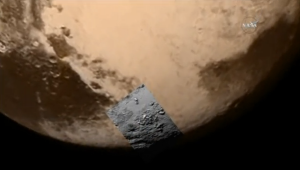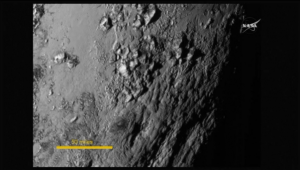 JULY 16 (Reuters) — NASA’s New Horizons science team revealed new images of distant Pluto on Wednesday (July 15), revealing methane gas, and topography complete with mountains and water “in great abundance.”
JULY 16 (Reuters) — NASA’s New Horizons science team revealed new images of distant Pluto on Wednesday (July 15), revealing methane gas, and topography complete with mountains and water “in great abundance.”
A U.S. spacecraft sailed past the tiny planet Pluto in the distant reaches of the solar system on Tuesday (July 15), capping a journey of 3 billion miles (4.88 billion km) that began nine and a half years ago.
The NASA New Horizons spacecraft passed by the ice-and-rock planetoid and its entourage of five moons at 7:49 a.m. EDT (1149 GMT). The event culminated an initiative to survey the solar system that the space agency embarked upon more than 50 years ago.
“Yesterday, America’s space program took another historic leap for humankind. Today, the new horizons team is bringing what was previously a blurred point of light into focus,” said Dwayne Brown of NASA’s Office of Communications.
About 13 hours after its closest approach to Pluto, the last major unexplored body in the solar system, New Horizons phoned home, signaling that it had survived its 31,000 miles per hour (49,000 km per hour) blitz through the Pluto system.
Managers had estimated there was a 1-in-10,000 chance a debris strike could destroy New Horizons as it soared just 7,750 miles (12,472 km) – about the distance from New York to Mumbai – from Pluto.
But right on time, New Horizons made radio contact with flight controllers at the Johns Hopkins University Applied Physics Lab outside Baltimore, sparking a wave of shouts and applause from an overflow crowd gathered to watch the drama unfold.
New Horizons spent more than eight hours after its closest approach looking back at Pluto for a series of experiments to study the planet’s atmosphere and photograph its night-side using light reflected off its primary moon Charon.
Sending back its first post-flyby signal took another four-and-a-half hour, the time it takes radio signals, traveling at light speed; to travel the 3 billion miles (4.88 billion km) back to Earth.
Already, the trickle of images and measurements relayed from New Horizons before Tuesday’s pass by Pluto has changed scientists’ understanding of this diminutive world, which is smaller than Earth’s moon.
Once considered an icy, dead world, the planetoid has yielded signs of geological activity, with evidence of past and possibly present-day tectonics, or movements of its crust.
“The steep topography means that the bedrock that makes those mountains must be made of H20 — of water-ice. So even before the composition team tells us that they found places where the nitrogen veneer has been eroded, or scraped off, and we see water-ice on Pluto for the first time, we can be very sure that the water is there in great abundance.,” said Alan Stern, New Horizons lead scientist, with the Southwest Research Institute in Boulder, Colorado.
Pluto circles the sun every 248 years in a highly tilted orbit that creates radical changes from season to season. Pluto travels closer to the sun than the orbit of Neptune before it cycles back into the solar system’s deep freeze more than 40 times farther away than Earth.







